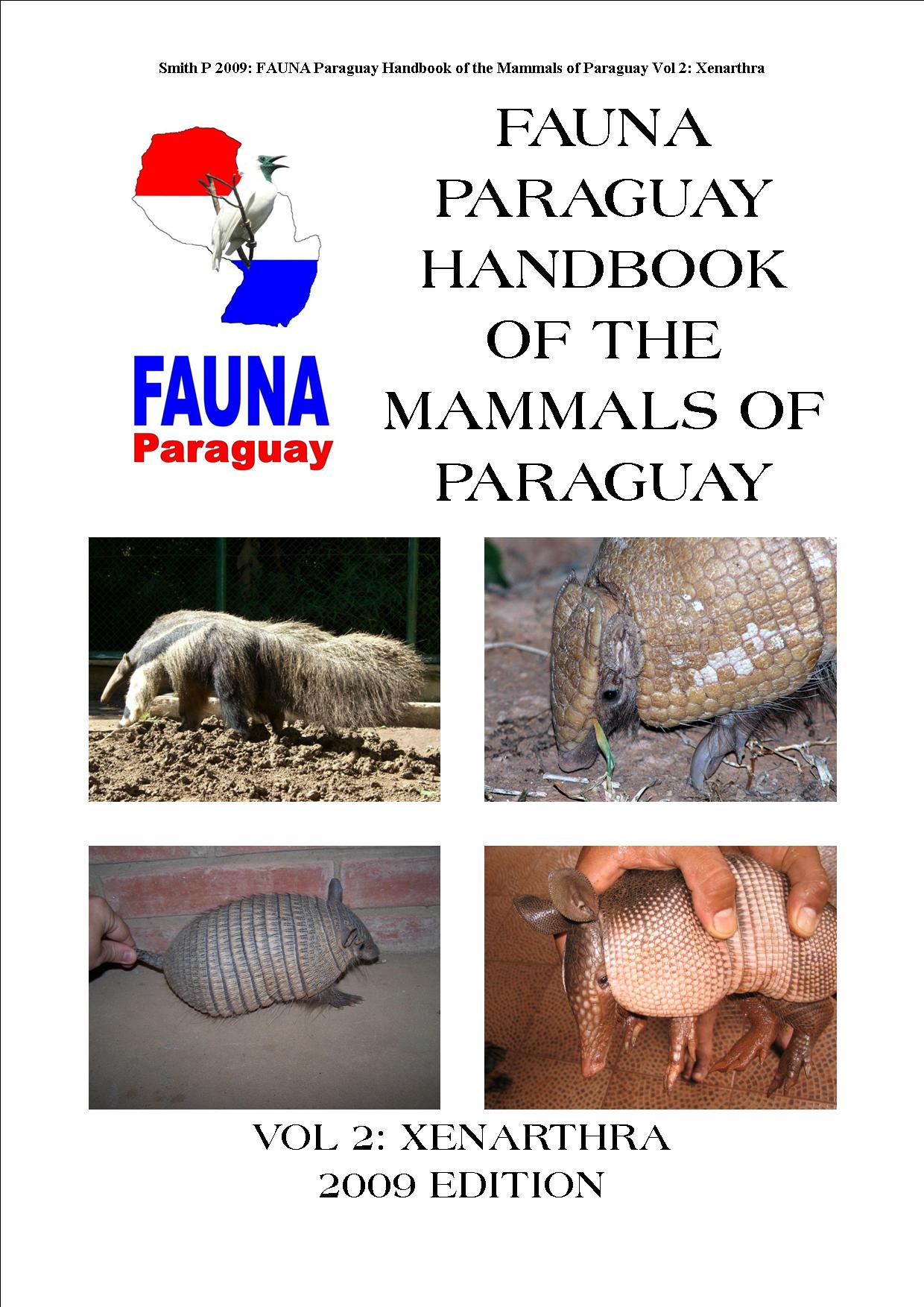
Designed by Paul Smith 2006. This website is copyrighted by law.
Material contained herewith may not be used without the prior written permission of FAUNA Paraguay.
Photographs on this web-site were taken by Paul Smith, Hemme Batjes, Regis Nossent,
Alberto Esquivel, Arne Lesterhuis, José Luis Cartes, Rebecca Zarza and Hugo del Castillo and are used with their permission.
Click on the species links for access to the image gallery.
Click on the HBook icon on the right hand side for access to pdfs of the FAUNA Paraguay Handbook of the Mammals of Paraguay Volume 2 Xenarthra.
See below for a key to the Paraguayan species.
FAMILY MYRMECOPHAGIDAE - ANTEATERS
General characteristics: Two distinctive species with elongated snout, small eyes and small rounded ears. The mouth is much reduced and located at the tip of the snout. Both species are equipped with a long sticky tongue adapted for hunting ants and termites, their principal food. Both species have four digits on the front foot (though greatly reduced in Tamandua), armed with large, viciously hooked claws (particularly the third) designed to break down the nests of their prey. As a result of this they walk on their “wrists” which are marked with a special thickened pad. Their food, though ubiquitous, is of low nutritional value and the anteaters have a correspondingly low metabolic rate. Both species give birth to a single young and exhibit advanced parental care. The small mouth and clawed feet are unsuitable for transporting young, so they ride on the back of the parent until they are old enough to fend for themselves. Fossils are known from the early Miocene of South America.
Cranial characteristics: Broad interorbital region. Incomplete zygomatic arch. Greatly elongated snout. Posterior margin of the palate formed by the pterygoids.
Dental characteristics: Teeth are lacking in this family.
Skeletal characteristics: Ribs have a double articulation with the sternal element.
Myrmecophaga Linnaeus, 1758: Giant Anteater
This is a monotypic genus. Synonyms adapted from Gardner (2007)
Synonyms:
Myrmecophaga Linnaeus 1758:35. Type species Myrmecophaga tridactyla Linnaeus (1758).
Nyrmecophaga Beckstein 1801:1346. Incorrect spelling.
Myrmecopha G.Fischer 1803:333. Incorrect spelling.
Myrmecophagus Gray 1825:343. Unjustified emendation.
Falcifer Rehn 1900:576. Type species Myrmecophaga jubata Linnaeus (1766) by monotypy.
General characteristics: Immediately idenfitiable by its huge size and long, hairy, non-prehensile tail. Body hair long, shorter on the head. Pectoral mammae are present. Digit I of forefeet possesses a short and sharp, but inconspicuous claw. Exclusively terrestrial.Fossils known from the early Pleistocene of South America.
Cranial characteristics: (Fig 1) Rostrum much longer than brain case.
Skeletal characteristics: Clavicles rudimentary.
Taxonomy: Rehn proposed Falcifer as a replacement generic name as he was under the mistaken belief that the type species of Myrmecophaga was M.tetradactyla (=Tamandua tetrdactyla).
Mymecophaga tridactyla - Giant Anteater
Tamandua Gray, 1825: Tree Anteaters
There are two species in this genus, one of which occurs in Paraguay. Synonyms adapted from Gardner (2007)
Synonyms:
Myrmecophaga Linnaeus 1758:35. In part
Tamandua Gray 1825:343. No type mentioned, Myrmecophaga tamandua G.Cuvier (1798) inferred.
Tamanduas F.Cuvier 1829:501. French vernacular. Unavailable.
Uroleptes Wagler 1830:36. Type species Myrmecophaga tetradactyla Linnaeus (1758) by monotypy.
Dryoryx Gloger 1841:112. No type species mentioned.
Uropeltes Alston 1880:191. Incorrect spelling.
General characteristics: A single species of semi-arboreal anteater with a prehensile-tipped tail, naked on the ventral portion. Body hair short and smooth. Fossils known from the Pleistocene of South America.
Cranial characteristics: Rostrum approximately half the greatest length of the skull.
Tamandua tetradactyla - Southern Tamandua
Key to Adults of Paraguayan Species of Anteaters
1a Large size, total length >180cm. Predominant colouration blackish-grey. Tail long and bushy. Exclusively terrestrial...............................................................................................................Myrmecophaga tridactyla
1b Small size, total length <105cm. Predominant colouration creamy-yellow with variable dark patch across shoulder and forelegs. Tail long and narrow, not bushy. Semi-arboreal...................Tamandua tetradactyla
Online Resources
Edentate Specialist Group - Publishes the online journal Edentata dealing with armadillos, sloths and anteaters.
REFERENCES
Diaz MM & Barquez RM 2002 - Los Mamíferos de Jujuy, Argentina - LOLA.
Emmons LH & Feer F 1999 - Mamíferos de los Bosques Húmedos de América Tropical - FAN Bolivia.
Gardner AL 2007 - Mammals of South America Volume 1: Marsupials, Xenarthrans, Shrews and Bats - University of Chicago Press.
Redford K & Eisenberg JF 1992 - Mammals of the Neotropics Vol 2: The Southern Cone Chile, Argentina, Uruguay and Paraguay - University of Chicago Press.




